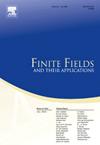On the existence of Galois self-dual GRS and TGRS codes
IF 1.2
3区 数学
Q1 MATHEMATICS
引用次数: 0
Abstract
Let be a prime power and e be an integer with . e-Galois self-dual codes are generalizations of Euclidean and Hermitian ( with even m) self-dual codes. In this paper, for a linear code and a nonzero vector , we give a sufficient and necessary condition for the dual extended code of to be e-Galois self-orthogonal. From this, a new systematic approach is proposed to prove the existence of e-Galois self-dual codes. By this method, we prove that e-Galois self-dual (extended) generalized Reed-Solomon (GRS) codes of length do not exist, where . Moreover, based on the non-GRS properties of twisted GRS (TGRS) codes, we show that in many cases e-Galois self-dual (extended) TGRS codes do not exist. Furthermore, we present a sufficient and necessary condition for -TGRS codes to be Hermitian self-dual, and then construct several new classes of Hermitian self-dual -TGRS and -TGRS codes.
论伽罗瓦自对偶GRS码和TGRS码的存在性
设q=pm为质数幂,e为0≤e≤m−1的整数。e-伽罗瓦自对偶码是欧几里得自对偶码(e=0)和厄米自对偶码(e=m2,偶m)的推广。本文针对线性码C和非零向量u∈Fqn,给出了C的对偶扩展码C_[u]是e-伽罗瓦自正交的充要条件。在此基础上,提出了一种新的系统方法来证明e-伽罗瓦自对偶码的存在性。利用该方法证明了长度为n>;min ({pe+1,pm−e+1})的e-伽罗瓦自对偶(扩展)广义Reed-Solomon (GRS)码不存在,其中1≤e≤m−1。此外,基于扭曲GRS (TGRS)码的非GRS性质,我们证明了在许多情况下e-伽罗瓦自对偶(扩展)TGRS码不存在。进一步地,我们给出了()-TGRS码是厄米自对偶的充要条件,并构造了几个新的厄米自对偶(+)-TGRS和()-TGRS码。
本文章由计算机程序翻译,如有差异,请以英文原文为准。
求助全文
约1分钟内获得全文
求助全文
来源期刊
CiteScore
2.00
自引率
20.00%
发文量
133
审稿时长
6-12 weeks
期刊介绍:
Finite Fields and Their Applications is a peer-reviewed technical journal publishing papers in finite field theory as well as in applications of finite fields. As a result of applications in a wide variety of areas, finite fields are increasingly important in several areas of mathematics, including linear and abstract algebra, number theory and algebraic geometry, as well as in computer science, statistics, information theory, and engineering.
For cohesion, and because so many applications rely on various theoretical properties of finite fields, it is essential that there be a core of high-quality papers on theoretical aspects. In addition, since much of the vitality of the area comes from computational problems, the journal publishes papers on computational aspects of finite fields as well as on algorithms and complexity of finite field-related methods.
The journal also publishes papers in various applications including, but not limited to, algebraic coding theory, cryptology, combinatorial design theory, pseudorandom number generation, and linear recurring sequences. There are other areas of application to be included, but the important point is that finite fields play a nontrivial role in the theory, application, or algorithm.

 求助内容:
求助内容: 应助结果提醒方式:
应助结果提醒方式:


